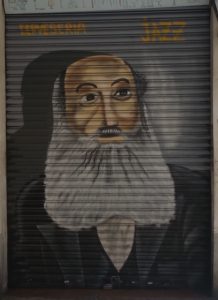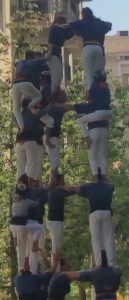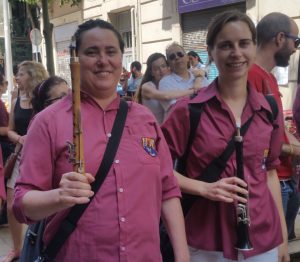Last Sunday we decided to visit a different neighborhood “El Poble-Sec” for lunch. The bike share racks near our apartment were empty, so we decided to take the bus. The bus let us off a bit wide of our intended mark, and with no particular agenda in mind we stopped for lunch at a cafe and then took a walk. As always, we encountered various examples of interesting signs and other street art. 
 The sign on the left in particular struck me as great advertising, as I now have an overwhelming urge to visit this jazz bar soon. …But I digress… Shortly after passing this sign, we saw a number of people dressed in a peculiar style and heard some kind of instrumental music wailing in the distance.
The sign on the left in particular struck me as great advertising, as I now have an overwhelming urge to visit this jazz bar soon. …But I digress… Shortly after passing this sign, we saw a number of people dressed in a peculiar style and heard some kind of instrumental music wailing in the distance.
Turn another corner and there are about 5 human towers in various stages of constuction! The word for these towers in Catalan is: Castell
I had heard that this was a form of sport/entertainment/amusement? specific to Catalonia, but had not seen any examples until now. Looking into it further, it appears that castells have been declared by UNESCO to be amongst the “Masterpieces of the Oral and Intangible Heritage of Humanity”.
And it’s great entertainment to watch them build and dismantle them! See ( https://youtu.be/079ZTI1y2Wo )
In Catalan, the word castell means castle.
The castell is built in two phases. First, the pinya—the base of the tower—is formed. People forming higher levels of the tower move to a position from which they can easily get to their places in the tower. This is done slowly and carefully, and as subsequent base levels are completed the castellers in the pinya determine if their base is solid enough for construction to continue. Then, when the signal to proceed is given, bands begin to play the traditional Toc de Castells music as a hush comes over spectators of the event. The upper layers of the tower are built as quickly as possible in order to put minimal strain on the lower castellers, who bear most of the weight of the castell. The disassembly of the castell, done amidst the cheering of the crowd, is often the most treacherous stage of the event.
The gralla –an old kind of pipe– and the timbal –a small drum– are the traditional musical accompaniment to castle performances and are as much an exciting part of it as the castle building in itself.

A castell is considered a success when assembly and disassembly can be done in complete succession. The assembly is complete once all castellers have climbed into their designated places, and the enxaneta climbs into place at the top and raises one hand with four fingers erect, in a gesture said to symbolize the stripes of the Catalan flag. The enxaneta then climbs down the other side of the castell, after which the remaining levels of castellers descend in highest to lowest order until all have reached safety.
Aside from the people who climb to form the upper parts of the tower, others are needed to form the pinya, or bottom base of the castell, to sustain its weight. Members of the pinya (most often men) also act as a ‘safety net’ if the tower structure collapses, cushioning the fall of people from the upper levels. It is not uncommon—when not in competitions—for other colles to assist in the pinya when a small colla is attempting a specially demanding structure in terms of people needed.
(Next video: https://youtu.be/m5SNl9DiN8E )